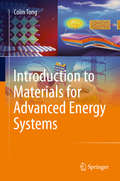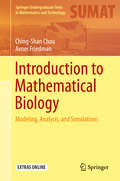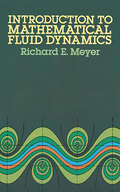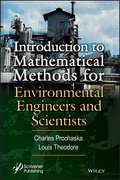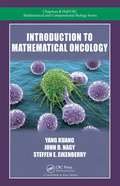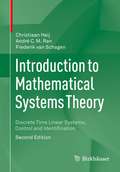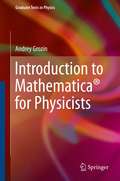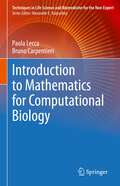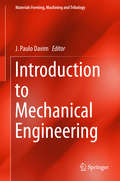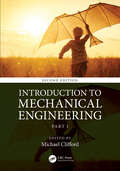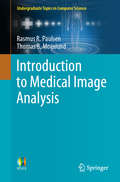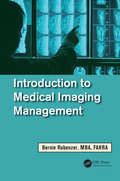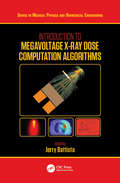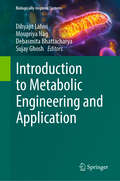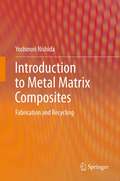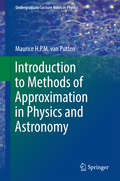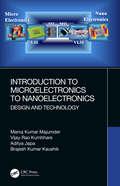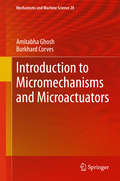- Table View
- List View
Introduction to Mass Spectrometry
by O. David Sparkman J. Throck WatsonCompletely revised and updated, this text provides an easy-to-read guide to the concept of mass spectrometry and demonstrates its potential and limitations. Written by internationally recognised experts and utilising "real life" examples of analyses and applications, the book presents real cases of qualitative and quantitative applications of mass spectrometry. Unlike other mass spectrometry texts, this comprehensive reference provides systematic descriptions of the various types of mass analysers and ionisation, along with corresponding strategies for interpretation of data. The book concludes with a comprehensive 3000 references.This multi-disciplined text covers the fundamentals as well as recent advance in this topic, providing need-to-know information for researchers in many disciplines including pharmaceutical, environmental and biomedical analysis who are utilizing mass spectrometry
Introduction to Materials for Advanced Energy Systems
by Colin TongThis first of its kind text enables today’s students to understand current and future energy challenges, to acquire skills for selecting and using materials and manufacturing processes in the design of energy systems, and to develop a cross-functional approach to materials, mechanics, electronics and processes of energy production. While taking economic and regulatory aspects into account, this textbook provides a comprehensive introduction to the range of materials used for advanced energy systems, including fossil, nuclear, solar, bio, wind, geothermal, ocean and hydropower, hydrogen, and nuclear, as well as thermal energy storage and electrochemical storage in fuel cells. A separate chapter is devoted to emerging energy harvesting systems. Integrated coverage includes the application of scientific and engineering principles to materials that enable different types of energy systems. Properties, performance, modeling, fabrication, characterization and application of structural, functional and hybrid materials are described for each energy system. Readers will appreciate the complex relationships among materials selection, optimizing design, and component operating conditions in each energy system. Research and development trends of novel emerging materials for future hybrid energy systems are also considered. Each chapter is basically a self-contained unit, easily enabling instructors to adapt the book for coursework. This textbook is suitable for students in science and engineering who seek to obtain a comprehensive understanding of different energy processes, and how materials enable energy harvesting, conversion, and storage. In setting forth the latest advances and new frontiers of research, the text also serves as a comprehensive reference on energy materials for experienced materials scientists, engineers, and physicists. Includes pedagogical features such as in-depth side bars, worked-out and end-of- chapter exercises, and many references to further reading Provides comprehensive coverage of materials-based solutions for major and emerging energy systems Brings together diverse subject matter by integrating theory with engaging insights
Introduction to Mathematical Biology
by Avner Friedman Ching Shan ChouThis book isbased on a one semester course that the authors have been teaching for severalyears, and includes two sets of case studies. The first includeschemostat models, predator-prey interaction, competition among species, thespread of infectious diseases, and oscillations arising from bifurcations. In developing these topics, readers will also be introduced to the basictheory of ordinary differential equations, and how to work with MATLAB withouthaving any prior programming experience. The second set of case studies were adapted fromrecent and current research papers to the level of the students. Topicshave been selected based on public health interest. This includes therisk of atherosclerosis associated with high cholesterol levels, cancer andimmune interactions, cancer therapy, and tuberculosis. Readers willexperience how mathematical models and their numerical simulations can provideexplanations that guide biological and biomedical research. Considered to be the undergraduate companion tothe more advanced book "Mathematical Modeling of BiologicalProcesses" (A. Friedman, C. -Y. Kao, Springer - 2014), this book isgeared towards undergraduate students with little background in mathematics andno biological background.
Introduction to Mathematical Fire Modeling
by Marc L. JanssensComputer simulation proves to be a valuable tool for the analysis and prediction of compartment fires. With the proper understanding and software, fire safety professionals can use modeling tools and methods to find answers to many critical questions relating to the prevention, investigation, and reconstruction of compartment fires.Thorough
Introduction to Mathematical Fluid Dynamics
by Richard E. MeyerFluid dynamics, the behavior of liquids and gases, is a field of broad impact that encompasses aspects of physics, engineering, oceanography, and meteorology. Full understanding demands fluency in higher mathematics, the only language of fluid dynamics. This introductory text is geared toward advanced undergraduate and graduate students in applied mathematics, engineering, and the physical sciences. It assumes a knowledge of calculus and vector analysis.Author Richard E. Meyer notes, "This core of knowledge concerns the relation between inviscid and viscous fluids, and the bulk of this book is devoted to a discussion of that relation." Dr. Meyer develops basic concepts from a semi-axiomatic foundation, observing that such treatment helps dispel the common impression that the entire subject is built on a quicksand of assorted intuitions. His topics include kinematics, momentum principle and ideal fluid, Newtonian fluid, fluids of small viscosity, some aspects of rotating fluids, and some effects of compressibility. Each chapter concludes with a set of problems.
Introduction to Mathematical Fluid Dynamics (Dover Books on Physics)
by Richard E. MeyerFluid dynamics, the behavior of liquids and gases, is a field of broad impact that encompasses aspects of physics, engineering, oceanography, and meteorology. Full understanding demands fluency in higher mathematics, the only language of fluid dynamics. This introductory text is geared toward advanced undergraduate and graduate students in applied mathematics, engineering, and the physical sciences. It assumes a knowledge of calculus and vector analysis.Author Richard E. Meyer notes, "This core of knowledge concerns the relation between inviscid and viscous fluids, and the bulk of this book is devoted to a discussion of that relation." Dr. Meyer develops basic concepts from a semi-axiomatic foundation, observing that such treatment helps dispel the common impression that the entire subject is built on a quicksand of assorted intuitions. His topics include kinematics, momentum principle and ideal fluid, Newtonian fluid, fluids of small viscosity, some aspects of rotating fluids, and some effects of compressibility. Each chapter concludes with a set of problems.
Introduction to Mathematical Methods for Environmental Engineers and Scientists
by Louis Theodore Charles ProchaskaThe material in this book attempts to address mathematical calculations common to both the environmental science and engineering professionals. The book provides the reader with nearly 100 solved illustrative examples. The interrelationship between both theory and applications is emphasized in nearly all of the 35 chapters. One key feature of this book is that the solutions to the problems are presented in a stand-alone manner. Throughout the book, the illustrative examples are laid out in such a way as to develop the reader’s technical understanding of the subject in question, with more difficult examples located at or near the end of each set. In presenting the text material, the authors have stressed the pragmatic approach in the application of mathematical tools to assist the reader in grasping the role of mathematical skills in environmental problem-solving situations. The book is divided up into five (V) parts: Introduction Analytical Analysis Numerical Analysis Statistical Analysis Optimization
Introduction to Mathematical Oncology (Chapman & Hall/CRC Mathematical Biology Series)
by Yang Kuang John D. Nagy Steffen E. EikenberryIntroduction to Mathematical Oncology presents biologically well-motivated and mathematically tractable models that facilitate both a deep understanding of cancer biology and better cancer treatment designs. It covers the medical and biological background of the diseases, modeling issues, and existing methods and their limitations. The authors introduce mathematical and programming tools, along with analytical and numerical studies of the models. They also develop new mathematical tools and look to future improvements on dynamical models. After introducing the general theory of medicine and exploring how mathematics can be essential in its understanding, the text describes well-known, practical, and insightful mathematical models of avascular tumor growth and mathematically tractable treatment models based on ordinary differential equations. It continues the topic of avascular tumor growth in the context of partial differential equation models by incorporating the spatial structure and physiological structure, such as cell size. The book then focuses on the recent active multi-scale modeling efforts on prostate cancer growth and treatment dynamics. It also examines more mechanistically formulated models, including cell quota-based population growth models, with applications to real tumors and validation using clinical data. The remainder of the text presents abundant additional historical, biological, and medical background materials for advanced and specific treatment modeling efforts. Extensively classroom-tested in undergraduate and graduate courses, this self-contained book allows instructors to emphasize specific topics relevant to clinical cancer biology and treatment. It can be used in a variety of ways, including a single-semester undergraduate course, a more ambitious graduate course, or a full-year sequence on mathematical oncology.
Introduction to Mathematical Systems Theory: Discrete Time Linear Systems, Control and Identification
by Christiaan Heij André C.M. Ran Frederik van SchagenThis book provides an introduction to the theory of linear systems and control for students in business mathematics, econometrics, computer science, and engineering. The focus is on discrete time systems, which are the most relevant in business applications, as opposed to continuous time systems, requiring less mathematical preliminaries. The subjects treated are among the central topics of deterministic linear system theory: controllability, observability, realization theory, stability and stabilization by feedback, LQ-optimal control theory. Kalman filtering and LQC-control of stochastic systems are also discussed, as are modeling, time series analysis and model specification, along with model validation.This second edition has been updated and slightly expanded. In addition, supplementary material containing the exercises is now available on the Springer Link's book website.
Introduction to Mathematica® for Physicists
by Andrey GrozinThe basics of computer algebra and the language of Mathematica are described. This title will lead toward an understanding of Mathematica that allows the reader to solve problems in physics, mathematics, and chemistry. Mathematica is the most widely used system for doing mathematical calculations by computer, including symbolic and numeric calculations and graphics. It is used in physics and other branches of science, in mathematics, education and many other areas. Many important results in physics would never be obtained without a wide use of computer algebra.
Introduction to Mathematics for Computational Biology (Techniques in Life Science and Biomedicine for the Non-Expert)
by Paola Lecca Bruno CarpentieriThis introductory guide provides a thorough explanation of the mathematics and algorithms used in standard data analysis techniques within systems biology, biochemistry, and biophysics. Each part of the book covers the mathematical background and practical applications of a given technique. Readers will gain an understanding of the mathematical and algorithmic steps needed to use these software tools appropriately and effectively, as well how to assess their specific circumstance and choose the optimal method and technology. Ideal for students planning for a career in research, early-career researchers, and established scientists undertaking interdisciplinary research.
Introduction to Mechanical Engineering (Materials Forming, Machining and Tribology)
by J. Paulo DavimThis textbook fosters information exchange and discussion on all aspects of introductory matters of modern mechanical engineering from a number of perspectives including: mechanical engineering as a profession, materials and manufacturing processes, machining and machine tools, tribology and surface engineering, solid mechanics, applied and computational mechanics, mechanical design, mechatronics and robotics, fluid mechanics and heat transfer, renewable energies, biomechanics, nanoengineering and nanomechanics. At the end of each chapter, a list of 10 questions (and answers) is provided.
Introduction to Mechanical Engineering: Part 1
by Michael CliffordUpdated throughout for the second edition, Introduction to Mechanical Engineering: Part 1 continues to be the essential text for all first-year undergraduate students, alongside those studying for foundation degrees and HNDs. Written by an experienced team of lecturers at the internationally renowned University of Nottingham, this book provides a comprehensive grounding in the following core engineering topics: thermodynamics, fluid mechanics, solid mechanics, dynamics, electrical and electronic systems and material science. It includes questions and answers for instructors and for self-guided learning. As well as mechanical engineers, this book is highly relevant to civil, automotive and aerospace engineering students.
Introduction to Mechanical Engineering: Part 2
by Michael CliffordIntroduction to Mechanical Engineering: Part 2 is the essential text for all second-year undergraduate students as well as those studying foundation degrees and Higher National Diplomas. Written by an experienced team of lecturers at the internationally renowned University of Nottingham, the text provides thorough coverage of the following core engineering topics, fully updated for the Second Edition: Fluid dynamics Thermodynamics Solid mechanics Electromechanical drive systems Feedback and control theory Structural vibration As well as mechanical engineers, the text will be highly relevant to automotive, aeronautical/aerospace and general engineering students. All units include questions, with Units 4 and 5 including enhanced, detailed solutions online as a bonus feature.
Introduction to Mechanics of Particles and Systems
by Costas J. PapachristouThis book is based on the author’s lecture notes for his Introductory Newtonian Mechanics course at the Hellenic Naval Academy. In order to familiarize students with the use of several basic mathematical tools, such as vectors, differential operators and differential equations, it first presents the elements of vector analysis that are needed in the subsequent chapters. Further, the Mathematical Supplement at the end of the book offers a brief introduction to the concepts of differential calculus mentioned. The main text is divided into three parts, the first of which presents the mechanics of a single particle from both the kinetic and the dynamical perspectives. The second part then focuses on the mechanics of more complex structures, such as systems of particles, rigid bodies and ideal fluids, while the third part consists of 60 fully solved problems. Though chiefly intended as a primary text for freshman-level physics courses, the book can also be used as a supplemental (tutorial) resource for introductory courses on classical mechanics for physicists and engineers
Introduction to Medical Image Analysis (Undergraduate Topics in Computer Science)
by Thomas B. Moeslund Rasmus R. PaulsenThis easy-to-follow textbook presents an engaging introduction to the fascinating world of medical image analysis. Avoiding an overly mathematical treatment, the text focuses on intuitive explanations, illustrating the key algorithms and concepts in a way which will make sense to students from a broad range of different backgrounds.Topics and features: explains what light is, and how it can be captured by a camera and converted into an image, as well as how images can be compressed and stored; describes basic image manipulation methods for understanding and improving image quality, and a useful segmentation algorithm; reviews the basic image processing methods for segmenting or enhancing certain features in an image, with a focus on morphology methods for binary images; examines how to detect, describe, and recognize objects in an image, and how the nature of color can be used for segmenting objects; introduces a statistical method to determine what class of object the pixels in an image represent; describes how to change the geometry within an image, how to align two images so that they are as similar as possible, and how to detect lines and paths in images; provides further exercises and other supplementary material at an associated website.This concise and accessible textbook will be invaluable to undergraduate students of computer science, engineering, medicine, and any multi-disciplinary courses that combine topics on health with data science. Medical practitioners working with medical imaging devices will also appreciate this easy-to-understand explanation of the technology.
Introduction to Medical Imaging Management
by Bernard RubenzerIn the past, for the most part, people who moved into management positions in medical imaging were chosen because they were the best technologists. However, the skill set for technologists and supervisors/managers are vastly different. Even an MBA-educated person may not be ready to take on imaging management. As an example, when buying a very expe
Introduction to Medical Physics (Series in Medical Physics and Biomedical Engineering)
by Slavik Tabakov Tony Greener Stephen Keevil Renato Padovani Cornelius LewisThis textbook provides an accessible introduction to the basic principles of medical physics, the applications of medical physics equipment, and the role of a medical physicist in healthcare. Introduction to Medical Physics is designed to support undergraduate and graduate students taking their first modules on a medical physics course, or as a dedicated book for specific modules such as medical imaging and radiotherapy. It is ideally suited for new teaching schemes such as Modernising Scientific Careers and will be invaluable for all medical physics students worldwide. Key features: Written by an experienced and senior team of medical physicists from highly respected institutions The first book written specifically to introduce medical physics to undergraduate and graduate physics students Provides worked examples relevant to actual clinical situations
Introduction to Megavoltage X-Ray Dose Computation Algorithms (Series in Medical Physics and Biomedical Engineering)
by Jerry BattistaRead an exclusive interview with Dr. Jerry Battista here. A critical element of radiation treatment planning for cancer is the accurate prediction and delivery of a tailored radiation dose distribution inside the patient. Megavoltage x-ray beams are aimed at the tumour, while collateral damage to nearby healthy tissue and organs is minimized. The key to optimal treatment therefore lies in adopting a trustworthy three-dimensional (3D) dose computation algorithm, which simulates the passage of both primary and secondary radiation throughout the exposed tissue. Edited by an award-winning university educator and pioneer in the field of voxel-based radiation dose computation, this book explores the physics and mathematics that underlie algorithms encountered in contemporary radiation oncology. It is an invaluable reference for clinical physicists who commission, develop, or test treatment planning software. This book also covers a core topic in the syllabus for educating graduate students and residents entering the field of clinical physics. This book starts with a historical perspective gradually building up to the three most important algorithms used for today’s clinical applications. These algorithms can solve the same general radiation transport problem from three vantages: firstly, applying convolution-superposition principles (i.e. Green’s method); secondly, the stochastic simulation of radiation particle interactions with tissue atoms (i.e. the Monte Carlo method); and thirdly, the deterministic solution of the fundamental equations for radiation fields of x-rays and their secondary particles (i.e. the Boltzmann method). It contains clear, original illustrations of key concepts and quantities thoughout, supplemented by metaphors and analogies to facilitate comprehension and retention of knowledge. Features: Edited by an authority in the field, enhanced with chapter contributions from physicists with clinical experience in the fields of computational dosimetry and dose optimization Contains examples of test phantom results and clinical cases, illustrating pitfalls to avoid in clinical applications to radiation oncology Introduces four-dimensional (4D) dose computation, on-line dose reconstruction, and dose accumulation that accounts for tissue displacements and motion throughout a course of radiation therapy
Introduction to Metabolic Engineering and Application (Biologically-Inspired Systems #19)
by Moupriya Nag Dibyajit Lahiri Debasmita Bhattacharya Sujay GhoshThe book unlocks the future of metabolic research with our comprehensive resource, designed for scientists, clinicians, and industry professionals. This expertly curated collection delves into cutting-edge advancements in metabolic pathways, disease mechanisms, and innovative therapeutic strategies. Covering everything from fundamental biochemistry to translational medicine, our content bridges the gap between research and clinical application. Whether you're exploring metabolic disorders, precision medicine, or novel biomarkers, this resource provides in-depth insights backed by the latest scientific discoveries. Elevate your expertise and stay ahead in the dynamic field of metabolic sciences—your essential guide to ground breaking innovations awaits.
Introduction to Metal Matrix Composites
by Yoshinori NishidaThis book is the first of its kind to deal with fabrication processes of metal matrix composites (MMCs) theoretically, experimentally, systematically, and instructively. The theoretical bases of fabrication processes and recycling processes of MMCs are established in this volume. Most other books in the field are concerned with the mechanics of properties, which is not easy for readers to grasp, and they introduce fabrication processes only as techniques without theoretical discussion. Because this book provides a clear image of the fabrication processes of MMCs without using complicated mathematics, readers can use production theory to create new composites. Also, fundamental concepts of recycling of MMCs are given in this book for the first time so as to meet the demands for solving environmental problems. This work originally was published in Japanese and has attained a high reputation among Japanese professors and researchers in the field.
Introduction to Methods of Approximation in Physics and Astronomy
by Maurice H. P. M. van PuttenThis textbook provides students with a solid introduction to the techniques of approximation commonly used in data analysis across physics and astronomy. The choice of methods included is based on their usefulness and educational value, their applicability to a broad range of problems and their utility in highlighting key mathematical concepts. Modern astronomy reveals an evolving universe rife with transient sources, mostly discovered - few predicted - in multi-wavelength observations. Our window of observations now includes electromagnetic radiation, gravitational waves and neutrinos. For the practicing astronomer, these are highly interdisciplinary developments that pose a novel challenge to be well-versed in astroparticle physics and data-analysis. The book is organized to be largely self-contained, starting from basic concepts and techniques in the formulation of problems and methods of approximation commonly used in computation and numerical analysis. This includes root finding, integration, signal detection algorithms involving the Fourier transform and examples of numerical integration of ordinary differential equations and some illustrative aspects of modern computational implementation. Some of the topics highlighted introduce the reader to selected problems with comments on numerical methods and implementation on modern platforms including CPU-GPU computing. Developed from lectures on mathematical physics in astronomy to advanced undergraduate and beginning graduate students, this book will be a valuable guide for students and a useful reference for practicing researchers. To aid understanding, exercises are included at the end of each chapter. Furthermore, some of the exercises are tailored to introduce modern symbolic computation.
Introduction to Microelectronics to Nanoelectronics: Design and Technology
by Brajesh Kumar Kaushik Manoj Kumar Majumder Vijay Rao Kumbhare Aditya JapaFocussing on micro- and nanoelectronics design and technology, this book provides thorough analysis and demonstration, starting from semiconductor devices to VLSI fabrication, designing (analog and digital), on-chip interconnect modeling culminating with emerging non-silicon/ nano devices. It gives detailed description of both theoretical as well as industry standard HSPICE, Verilog, Cadence simulation based real-time modeling approach with focus on fabrication of bulk and nano-devices. Each chapter of this proposed title starts with a brief introduction of the presented topic and ends with a summary indicating the futuristic aspect including practice questions. Aimed at researchers and senior undergraduate/graduate students in electrical and electronics engineering, microelectronics, nanoelectronics and nanotechnology, this book: Provides broad and comprehensive coverage from Microelectronics to Nanoelectronics including design in analog and digital electronics. Includes HDL, and VLSI design going into the nanoelectronics arena. Discusses devices, circuit analysis, design methodology, and real-time simulation based on industry standard HSPICE tool. Explores emerging devices such as FinFETs, Tunnel FETs (TFETs) and CNTFETs including their circuit co-designing. Covers real time illustration using industry standard Verilog, Cadence and Synopsys simulations.
Introduction to Micromechanisms and Microactuators
by Amitabha Ghosh Burkhard CorvesThis book presents a basic introduction to micromechanisms and microactuators, particularly to their basic configurations and design. This book fills the persisting gap in the published literature on the mechanical manipulative aspects of micromechanisms. It also helps in offering specialized introductory courses on micromechanisms and microactuators not as part of MEMS sensing devices, but as mechanical manipulative systems. The level of the book is suitable for use in both undergraduate and introductory graduate programmes. The book presents an overview of miniaturization and scaling laws, basic design principles of micro-sized mechanisms and actuators, micro-fabrication processes, and some futuristic issues. The volume contains a large number of figures and illustrations for easy understanding by the readers. It will also be useful to researchers and professionals looking for an introduction to the topic.
Introduction to Modeling Cognitive Processes
by Tom VergutsAn introduction to computational modeling for cognitive neuroscientists, covering both foundational work and recent developments. Cognitive neuroscientists need sophisticated conceptual tools to make sense of their field&’s proliferation of novel theories, methods, and data. Computational modeling is such a tool, enabling researchers to turn theories into precise formulations. This book offers a mathematically gentle and theoretically unified introduction to modeling cognitive processes. Theoretical exercises of varying degrees of difficulty throughout help readers develop their modeling skills. After a general introduction to cognitive modeling and optimization, the book covers models of decision making; supervised learning algorithms, including Hebbian learning, delta rule, and backpropagation; the statistical model analysis methods of model parameter estimation and model evaluation; the three recent cognitive modeling approaches of reinforcement learning, unsupervised learning, and Bayesian models; and models of social interaction. All mathematical concepts are introduced gradually, with no background in advanced topics required. Hints and solutions for exercises and a glossary follow the main text. All code in the book is Python, with the Spyder editor in the Anaconda environment. A GitHub repository with Python files enables readers to access the computer code used and start programming themselves. The book is suitable as an introduction to modeling cognitive processes for students across a range of disciplines and as a reference for researchers interested in a broad overview.

